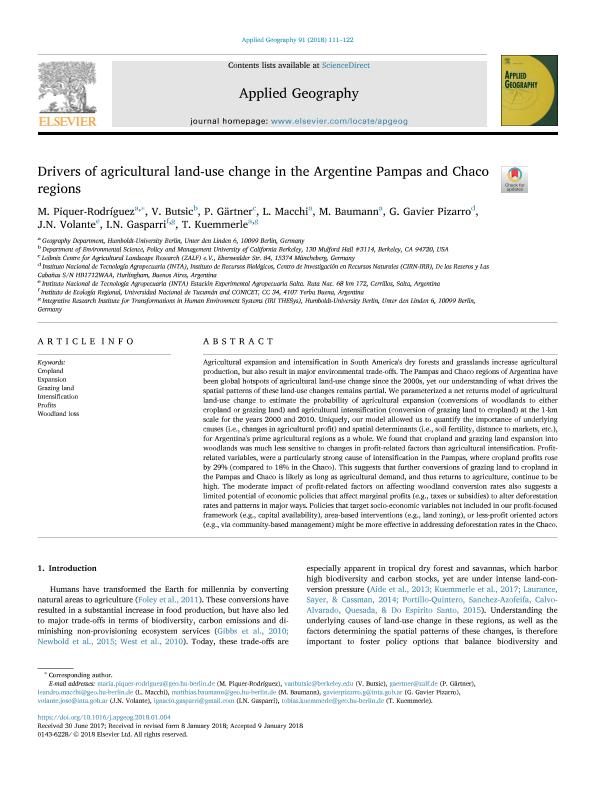Mostrar el registro sencillo del ítem
dc.contributor.author
Piquer Rodríguez, María

dc.contributor.author
Butsic, Van
dc.contributor.author
Gärtner, P.
dc.contributor.author
Macchi, Leandro

dc.contributor.author
Baumann, Matthias

dc.contributor.author
Gavier Pizarro, Gregorio

dc.contributor.author
Volante, José Norberto

dc.contributor.author
Gasparri, Nestor Ignacio

dc.contributor.author
Kuemmerle, Tobias

dc.date.available
2019-11-25T23:18:14Z
dc.date.issued
2018-02
dc.identifier.citation
Piquer Rodríguez, María; Butsic, Van; Gärtner, P.; Macchi, Leandro; Baumann, Matthias; et al.; Drivers of agricultural land-use change in the Argentine Pampas and Chaco regions; Elsevier; Applied Geography; 91; 2-2018; 111-122
dc.identifier.issn
0143-6228
dc.identifier.uri
http://hdl.handle.net/11336/90416
dc.description.abstract
Agricultural expansion and intensification in South America's dry forests and grasslands increase agricultural production, but also result in major environmental trade-offs. The Pampas and Chaco regions of Argentina have been global hotspots of agricultural land-use change since the 2000s, yet our understanding of what drives the spatial patterns of these land-use changes remains partial. We parameterized a net returns model of agricultural land-use change to estimate the probability of agricultural expansion (conversions of woodlands to either cropland or grazing land) and agricultural intensification (conversion of grazing land to cropland) at the 1-km scale for the years 2000 and 2010. Uniquely, our model allowed us to quantify the importance of underlying causes (i.e., changes in agricultural profit) and spatial determinants (i.e., soil fertility, distance to markets, etc.), for Argentina's prime agricultural regions as a whole. We found that cropland and grazing land expansion into woodlands was much less sensitive to changes in profit-related factors than agricultural intensification. Profit-related variables, were a particularly strong cause of intensification in the Pampas, where cropland profits rose by 29% (compared to 18% in the Chaco). This suggests that further conversions of grazing land to cropland in the Pampas and Chaco is likely as long as agricultural demand, and thus returns to agriculture, continue to be high. The moderate impact of profit-related factors on affecting woodland conversion rates also suggests a limited potential of economic policies that affect marginal profits (e.g., taxes or subsidies) to alter deforestation rates and patterns in major ways. Policies that target socio-economic variables not included in our profit-focused framework (e.g., capital availability), area-based interventions (e.g., land zoning), or less-profit oriented actors (e.g., via community-based management) might be more effective in addressing deforestation rates in the Chaco.
dc.format
application/pdf
dc.language.iso
eng
dc.publisher
Elsevier

dc.rights
info:eu-repo/semantics/openAccess
dc.rights
Atribución-NoComercial-CompartirIgual 2.5 Argentina (CC BY-NC-SA 2.5 AR)
dc.rights.uri
https://creativecommons.org/licenses/by-nc-sa/2.5/ar/
dc.subject
CROPLAND
dc.subject
EXPANSION
dc.subject
GRAZING LAND
dc.subject
INTENSIFICATION
dc.subject
PROFITS
dc.subject
WOODLAND LOSS
dc.subject.classification
Otras Ciencias Agrícolas

dc.subject.classification
Otras Ciencias Agrícolas

dc.subject.classification
CIENCIAS AGRÍCOLAS

dc.subject.classification
Conservación de la Biodiversidad

dc.subject.classification
Ciencias Biológicas

dc.subject.classification
CIENCIAS NATURALES Y EXACTAS

dc.title
Drivers of agricultural land-use change in the Argentine Pampas and Chaco regions
dc.type
info:eu-repo/semantics/article
dc.type
info:ar-repo/semantics/artículo
dc.type
info:eu-repo/semantics/publishedVersion
dc.date.updated
2019-10-16T20:57:12Z
dc.journal.volume
91
dc.journal.pagination
111-122
dc.journal.pais
Países Bajos

dc.journal.ciudad
Amsterdam
dc.description.fil
Fil: Piquer Rodríguez, María. Universität zu Berlin; Alemania
dc.description.fil
Fil: Butsic, Van. University of California at Berkeley; Estados Unidos
dc.description.fil
Fil: Gärtner, P.. Leibniz Centre for Agricultural Landscape Research; Alemania
dc.description.fil
Fil: Macchi, Leandro. Consejo Nacional de Investigaciones Científicas y Técnicas. Centro Científico Tecnológico Conicet - Tucumán; Argentina. Universität zu Berlin; Alemania
dc.description.fil
Fil: Baumann, Matthias. Universität zu Berlin; Alemania
dc.description.fil
Fil: Gavier Pizarro, Gregorio. Consejo Nacional de Investigaciones Científicas y Técnicas. Centro Científico Tecnológico Conicet - Tucumán; Argentina. Instituto Nacional de Tecnología Agropecuaria. Centro de Investigación de Recursos Naturales. Instituto de Recursos Biológicos; Argentina
dc.description.fil
Fil: Volante, José Norberto. Instituto Nacional de Tecnología Agropecuaria; Argentina
dc.description.fil
Fil: Gasparri, Nestor Ignacio. Universidad Nacional de Tucumán. Instituto de Ecología Regional. Consejo Nacional de Investigaciones Científicas y Técnicas. Centro Científico Tecnológico Conicet - Tucumán. Instituto de Ecología Regional; Argentina
dc.description.fil
Fil: Kuemmerle, Tobias. Universität zu Berlin; Alemania
dc.journal.title
Applied Geography
dc.relation.alternativeid
info:eu-repo/semantics/altIdentifier/url/https://www.sciencedirect.com/science/article/pii/S0143622817306872
dc.relation.alternativeid
info:eu-repo/semantics/altIdentifier/doi/https://doi.org/10.1016/j.apgeog.2018.01.004
Archivos asociados
